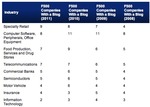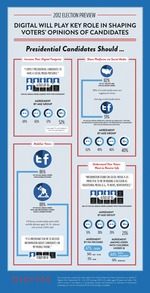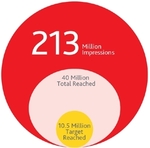Social media is, of course, all the rage these days. After all, "everyone's doing it so why shouldn't I?" is what most marketing directors think. So they dive in, created a Facebook page, open a Twitter account, start a blog and maybe even field a few questions on Quora. But then they sort of walk away. Well, 30 percent of them do according to a recent study from cloud computing company Pardot.
more »
A recent study from the University of Massachusetts at Dartmouth has found the adoption of social media usage among Fortune 500 companies has leveled off. Across multiple industries, usage of Twitter, Facebook and blogs in 2011 is level with or below that of 2010.
In 2010, 23 percent of Fortune 500 companies had a blog. In 2011, that figured remained unchanged at 23 percent. In 2010, 60 percent of Fortune 500 companies have a Twitter account. In 2011, 62 percent have an account. In 2010, 56 percent of Fortune 500 companies had a Facebook account. In 2011, 58 percent have an account.
more »
Just as it did four years ago, digital media will play an integral part in the upcoming 2012 Presidential election. A new study and infographic from Digitas finds 61 percent of social media users expect candidates to have a social media presence and 38 percent say candidate information found on social networks will influence their vote.
Unsurprisingly, younger folks (18-34) were most likely (51%) to say social networks will influence their choice of candidate.
Eighty six percent of social media users own mobile phones. Of these, 24 percent aged 18 - 34 feel it's important to receive information about presidential candidates on their mobile phones. The study also found that 88 percent of social media users who are registered voters have mobile phones.
The survey was conducted online with the United States by Harris Interactive on behalf of Digitas from September 21 - 23, 2011 among 2,361 U.S. adults aged 18 years and older, 1,701 of whom are registered voters.
A recent IBM study found that only 26 percent of CMOs are tracking blogs, 42 percent are tracking third party reviews and 48 percent are tracking consumer reviews to help shape their marketing strategies. The study was conducted across 1,700 chief marketing officers in 64 countries and 19 industries as a means to determine the focus on market circumstances versus individual consumer feedback.
Of the study and the shifting focus of CMOs, IBM researcher Carolyn Heller Baird said, "The inflection point created by social media represents a permanent change in the nature of customer relationships. Approximately 90 percent of all the real-time information being created today is unstructured data. CMO's who successfully harness this new source of insight will be in a strong position to increase revenues, reinvent their customer relationships and build new brand value."
more »
Last month, a study conducted by Boston University researchers John Byers and Georgia Zervas and Harvard University researcher Michael Mitzenmacher found that while Groupon and LivingSocial deals can increase the number Yelp reviews, they can also reduce Yelp scores by ten percent. Yelp reviews that mentioned the words "Groupon" or "coupon" lowered star ratings by ten percent. Reviews that mentioned both words showed a 20 percent drop.
The researchers examined 16,692 Groupon offers and 2,609 LivingSocial offers in 20 cities and 56,000 Yelp reviews for 2,332 merchants that ran 2,496 deals.
more »
Nielsen has released two new white papers, "Reaching the Right Audiences Online: Early Findings from Nielsen Online Campaign Ratings," and "Beyond Clicks and Impressions: Examining the Relationship Between Online Advertising and Brand Building." Tidbits from the two papers include:
- Online campaigns are being consistently delivered to people outside the advertiser's intended audience.
- Campaigns with high impressions are still only reaching a fraction of the intended audience.
- Online delivers audiences more effectively than some popular TV shows.
- Click-through rate is not the right metric to measure brand impact - virtually no relationship exists between clicks and brand metrics or offline sales.
- But, brand metrics for online campaigns can predict offline sales impact.
You can download each of the white papers here and here.
- This is just too funny. World Championship Nose Cleansing. All to promote a nasal spray.
- Having trouble getting started on a creative brief? There's an app for that. Brief Buddy.
- Wonderful Pistachios is out with a slew of new ads featuring the Facebook-slighted Winklevoss Twins, gooy Mr. Bill, crazy Crystal the Monkey, the angry...Angry Birds and the bootylicious Khloe Kardashian.
- Sony Ericsson partnered with artists, intellectuals, and other artists from around the world, provided each with a Sony Xperia phone and asked them to see what they could make with it. Then they documented the project.
more »
- Yawn. Yet another celebrity sells her body to PETA.
- See Tom Brady walk around in different pairs of UGG shoes. From M&C Saatchi LA.
- The 10 Most Controversial Ads in Fashion History
- Anne Hathaway is the new face of Tod's
- Chuck McCarthy (@ideasbychuck) finally makes it into advertising...sort of.
- The Webby Awards has launched its call for entry for its 16th annual awards event to be held Spring 2012. The early entry deadline for is October 28, 2011.
- Today, Nielsen released State of the Media: The Social Media Report - Q3 2011 a report on social media's influence on consumer behavior.
Last summer during Affiliate Summit in New York during a session given by Jeremy Shoemaker we learned Facebook ads that feature boobs and cleavage improve response rates by 61 percent. While we weren't at all surprised at that finding, we are very surprised at this latest Facebook ad response finding from Red Square Agency.
The agency ran several ads on Facebook touting the usual stuff agencies do. Then, as an experiment, they ran an ad that featured a cat named Cous Cous. The ad read, "This ad features a cat. It has nothing to do with Red Square Agency, but we hope you'll click on it anyway." People did. 78 percent more than they did the "regular"ads.
more »
Well here's a no-brainer. Back from Cannes and digging through the Adrants inbox full of press releases announcing the latest campaigns, hires, fires, account wins and losses and general idiocy like why we simply must talk to a particular ad exec because, god dammit, he's got something to tell us we've never, ever heard before in the history of advertising...we find this little item from EyeTrackShop.
EyeTrackShop tells us they've developed the first eye tracking solution for webcams which will "revolutionize the way in which businesses can conduct market research by bringing convenient, cost-effective marketing data to the masses."
Which is really just fancy PR speak for saying, "Now we can confirm what everyone already knows: people stare at ass" The take away? Obvious. Every ad should have an ass in it. Got that? Good. Now you can go on with your Tuesday armed with this very important knowledge which will dramatically alter they way you approach all future ad concepts.

|










